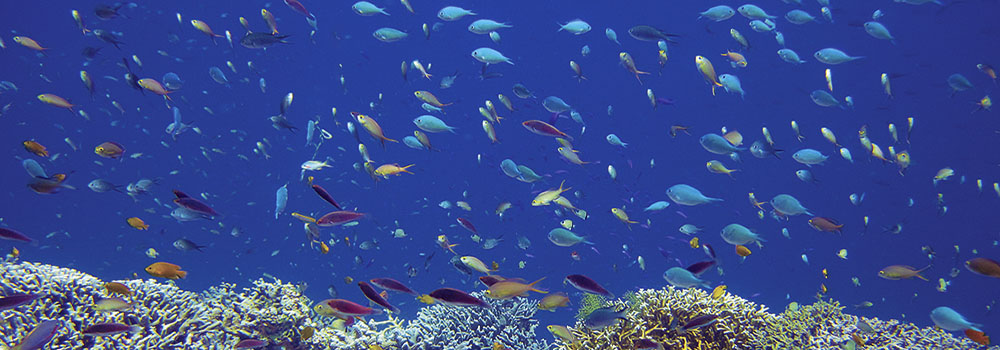Snorkeling the reefs of Kimbe Bay, Papua New Guinea!
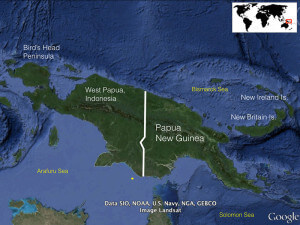 The Independent State of Papua New Guinea, or PNG, occupies the eastern portion of the world’s second largest island, New Guinea. It resides on the northern portion of the Indo-Australian tectonic plate that it shares with Australia. The country is dominated by mountainous terrain with dense, tropical rainforests filled with over 800 species of birds and home to approximately 7000 different colorful and fascinating cultures.
The Independent State of Papua New Guinea, or PNG, occupies the eastern portion of the world’s second largest island, New Guinea. It resides on the northern portion of the Indo-Australian tectonic plate that it shares with Australia. The country is dominated by mountainous terrain with dense, tropical rainforests filled with over 800 species of birds and home to approximately 7000 different colorful and fascinating cultures.x
Inaccessibility due to the rugged terrain as well as often-hostile villagers made exploring and cataloging terrestrial life difficult. Recent surveys suggest, however, that the terrestrial environments of PNG may be some of the most biologically diverse on the planet. Over 20,000 species of plants and trees can be found in the forests (compared to 80,000 species that can be found in the Amazon, an area nearly 15x larger) and new records of plants, insects, and mammals are being discovered each year!
x
In the surrounding azure blue seas the diversity levels are just as high. Located in the eastern portion of the coral triangle, a geographical term used to describe the region that possesses the world’s highest levels of marine biodiversity, the reef communities possess over 1000 species of tropical fishes and over 500 species of reef-building corals.
x
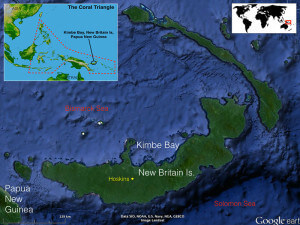 Our snorkeling tour in Papua New Guinea takes place in the overwhelmingly scenic Kimbe Bay on New Britain Island. Nestled snuggly between two volcanoes that reside on each side of the bay, Kimbe Bay fits right in with rugged landscapes and dense tropical rainforests that the island of New Guinea is known for. The marine environments of Kimbe Bay vary from shallow coral gardens and sea grass to exposed outer reefs and deep walls the plunge to incredible depths, and our plan is to experience them all (including the deep walls, but we’ll float above them). Hosting us in Kimbe Bay is the brand new M/V Oceania to explore the unique reefs of Kimbe Bay!
Our snorkeling tour in Papua New Guinea takes place in the overwhelmingly scenic Kimbe Bay on New Britain Island. Nestled snuggly between two volcanoes that reside on each side of the bay, Kimbe Bay fits right in with rugged landscapes and dense tropical rainforests that the island of New Guinea is known for. The marine environments of Kimbe Bay vary from shallow coral gardens and sea grass to exposed outer reefs and deep walls the plunge to incredible depths, and our plan is to experience them all (including the deep walls, but we’ll float above them). Hosting us in Kimbe Bay is the brand new M/V Oceania to explore the unique reefs of Kimbe Bay!
ITINERARY
 Our snorkeling tour begins and ends in Port Moresby. One internal flight (Port Moresby – Hoskins, New Britain Island and return). Upon arrival, transfer to Walindi Resort where we will stay the evening prior to boarding our boat the next day. Please note that the following is a general itinerary and that weather, tides, and other unforeseen or unavoidable circumstances may affect the schedule at any time.
Our snorkeling tour begins and ends in Port Moresby. One internal flight (Port Moresby – Hoskins, New Britain Island and return). Upon arrival, transfer to Walindi Resort where we will stay the evening prior to boarding our boat the next day. Please note that the following is a general itinerary and that weather, tides, and other unforeseen or unavoidable circumstances may affect the schedule at any time.
Day 1: Port Moresby / Hilton Port Moresby
Meals provided: D
Meet at the group hotel for our welcome dinner and trip orientation.
Day 2: New Britain Island / Kimbe Bay / Walindi Dive Resort
Our morning flight takes us to Hoskins Airport on New Britain Island where we meet with our transfer to Walindi Resort in Kimbe Bay. Kimbe Bay is a beautiful deep-water bay sprinkled with dozens of tiny to moderate-sized islands, each surrounded by lush, healthy coral reefs. We may have the opportunity to snorkel the house reef in the afternoon, but weather and time will dictate. Overnight: Walindi Dive Resort
Day 3: Kimbe Bay / Tuare Island
Meals provided: B,L,D
We begin our snorkeling tour visiting the island of Tuare, located along the northwestern edge of the Bay. The reefs that radiate from the island extend in some places for hundreds of meters and are nearly completely covered with healthy coral. Keep an eye out for sharks, fusiliers, anthias, bumphead parrotfish, and colorful nudibranchs. Overnight: M/V Oceania
Day 4 – 5: Witu Islands
Meals provided: B,L,D
The Witu Islands, remnants of an ancient, now deceased, volcano, are located about 20 miles outside of the bay to the northwest. We’ll spend two days snorkeling the reefs both inside and outside of the large caldera on Garove Island. We will snorkel on shallow reefs with dramatic drop-offs, spend time exploring a massive sinkhole with beautiful coral along the shallow perimeter, and visit coral gardens sheltered behind the massive volcanic walls. The reefs teem with fish as well as the sharks, turtles, and possibly a dugong. Overnight M/V Oceania
Day 6: Kepapa Island / Kimbe Island
Meals provided: B,L,D
Both islands have extensive hard coral gardens, Kepapa being generally shallow with gentle slopes to the deep, where Kimbe Island’s reef is shallow with vertical walls plunging to thousands of feet. The coral communities at each location are slightly different as Kepapa Island does not (seem) to be exposed to large oceanic waves the way Kimbe Island is. Thus, coral colonies at Kimbe Island tend to be large robust colonies while colonies at Kepapa are of a variety of shapes including delicate branching and scroll coral. Overnight M/V Oceania
Day 7: Kimbe Island / Susan’s Reef
Meals provided: B,L,D
We spend the morning enjoying more of the reefs of Kimbe Island before cruising to visit a series of tiny islands that erupt from the depths of the deep bay. The the reefs around the islands are very narrow, sometimes only a dozen feet wide, and plunge vertically on all sides. Bright red sea whips and sea fans can be found here, as well as thousands of tiny reef fishes that converge along the margins in such numbers, it looks like a continuous skin over the reef. Overnight: M/V Oceania
Day 8: Big Malumalu and the Zero
Meals provided: B,L,D
Big Malumalu is a beautiful island with really good birding. The reef around the island is fairly convoluted but has a definite reef line. The draw, however, is the black sand. Black sand habitats support a variety of cryptic and interesting critters including snails, nudibranchs, scorpionfishes, seahorses, and colorful sea stars. In the afternoon, we cruise deep into the head of the bay where we get to explore another interesting and essential habitat, sea grass. Much like black sand, sea grass provides a habitat for a variety of bizarre critters including many species of pipefishes, seahorses, crab-eyed gobies, and dozens of species of echinoderms. This area includes another treat, the chance to see a WWII Japanese Zero. It is almost fully intact and sitting upright in ab out 45 feet of water. Overnight M/V Oceania
Day 9: Restorff Island
Meals provided: B
This is easily one of the most scenic and best moorings in all of Kimbe Bay. The boat moors close to a sloping sand bank that trails into the water from the picture perfect beach. The reef is so close we enter the water directly from the main boat (but will still have dinghies for safety). The shallow walls of the island possess some of the most colorful soft corals and sea fans and working our way in the shallow against the island, we can find lots of colorful critters like nudibranchs, snails, tunicates, and more soft corals. We will stay here all day to enjoy the extensive reef and beautiful scenery. Overnight M/V Oceania
Day 10: Vanessa’s Reef / Susan’s Reef
Meals provided: B
Vanessa’s Reef is a continuation of Susan’s Reef, narrow ridges with plunging walls on all sides, and are fairly unique to Kimbe Bay. We will spend the day enjoying the reefs and especially for the chance to hover just a few feet over vibrant coral and fish with plunging walls on each side just a few feet way on each side. Sharks, turtles, and huge schools of reef fish also keep us company while we snorkel along the coral ridge. OVernight M/V Oceania
Day 11: Walinidi Dive Resort
Meals provided: B
We return to the resort, but our snorkeling is not over. We’ll spend the day exploring the house reef which begins in front of the resort and is quite extensive. Though we will have our meals at the resort we are still staying on the boat overnight. Overnight M/V Oceania
Day 12: Port Moresby / Hilton Port Moresby
Meals provided: B
Transfer in the morning to Hoskins airport for our flight back to Port Moresby. Farewell dinner at our group hotel. Overnight Hilton Port Moresby
Day 13: International transfers or extensions
Meals provided: B
DEPARTURES
We are currently exploring dates in 2025. Please Contact Us for more information.
Accommodations: M/V Oceania
Guides: TBD
Tour cost includes:
- Accommodations on day 1 through day 13
- All meals on days 2 through 12 (dinner on day 1 – breakfast on day 13)
- All internal transfers including international arrival and departure transfers
- Non-alcoholic beverages
- All snorkeling and park fees
- All gratuities
Tour cost does not include:
- Round-trip international airfare
- Additional hotel accommodations and meals as a result of travel outside of the program dates
- Visa requirements including payments
- Alcoholic beverages
- International departure taxes
- Extra / overweight baggage fees
- Trip insurance (recommended; (we recommend Travel Guard, World Nomads, or Travel Insure)
- DAN insurance (required unless personal insurance program has worldwide emergency evacuation services)
- Additional accommodations while on tour in the event of flight schedule changes or events of force majeure
- Fuel surcharges (if applicable)
Cancellation policy:
180 – 91 days prior to departure: 50% of trip cost
90 days or less prior to departure: 100% of tour cost
Please see our Terms and Conditions
ACCOMMODATIONS
We use the finest live-aboard boat in Papua New Guinea to host us on snorkeling adventures in Kimbe Bay, the M/V Oceania. In Kimbe, we stay at the Walindi Resort. Please visit our accommodations page for more photos or use the link to visit the resort/live-aboard website.
M/V Oceania
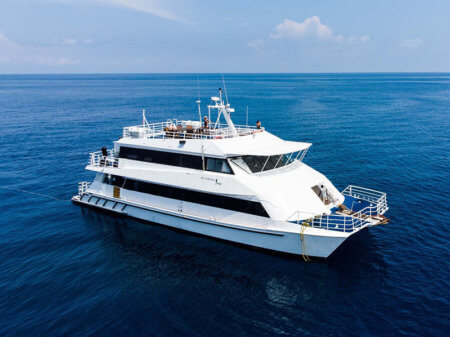 The M/V Oceania is an 88-ft (27 m) catamaran accommodating up to 16 guests in eight above-deck cabins, each with ensuite bathroom and sea views. The lounge / dining area has two long tables and a spacious couch which are perfect for relaxing and with multiple charging sockets installed along the footboard you can also charge your device. There is also a shared restroom on this deck. The covered upper deck features tables and chairs in both the sun and the shade, making this is the perfect place for relaxing, catching sun, or snacking at sunset. She carries the full compliment of safety equipment including GPS, EPIRB, vest, and tows two dinghies that we use for our snorkeling activities.
The M/V Oceania is an 88-ft (27 m) catamaran accommodating up to 16 guests in eight above-deck cabins, each with ensuite bathroom and sea views. The lounge / dining area has two long tables and a spacious couch which are perfect for relaxing and with multiple charging sockets installed along the footboard you can also charge your device. There is also a shared restroom on this deck. The covered upper deck features tables and chairs in both the sun and the shade, making this is the perfect place for relaxing, catching sun, or snacking at sunset. She carries the full compliment of safety equipment including GPS, EPIRB, vest, and tows two dinghies that we use for our snorkeling activities.
WALINDI RESORT
 Bungalows at Walindi Resort are free standing “bure” style accommodations, built using local timbers and materials. Nestled in the tropical gardens of Walindi, the bungalows are fan cooled and fully screened with beautiful views of the ocean. Each room have a private verandah, ensuite facilities, and are accessed by paths winding through the rainforest gardens. The restaurant offers three meals daily (included in the tariff) and fare is Western and Asian style, delicious and plentiful, featuring local seafoods, fruits and vegetables.
Bungalows at Walindi Resort are free standing “bure” style accommodations, built using local timbers and materials. Nestled in the tropical gardens of Walindi, the bungalows are fan cooled and fully screened with beautiful views of the ocean. Each room have a private verandah, ensuite facilities, and are accessed by paths winding through the rainforest gardens. The restaurant offers three meals daily (included in the tariff) and fare is Western and Asian style, delicious and plentiful, featuring local seafoods, fruits and vegetables.
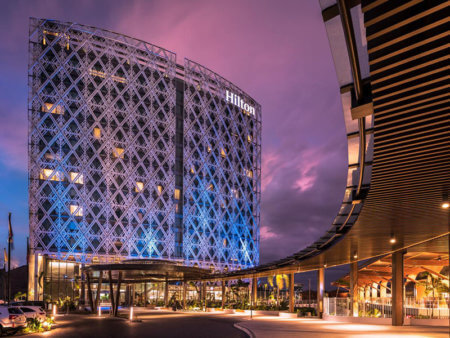 The Hilton Port Moresby is located in central Port Moresby, and is connected to the Kutubu Convention Center. Jacksons International Airport is a 10-minute drive and we’re four kilometers from the Papua New Guinea National Museum and Art Gallery. Five restaurants offering international cuisines, and three bars offer options for food and drink. Pool facilities.
The Hilton Port Moresby is located in central Port Moresby, and is connected to the Kutubu Convention Center. Jacksons International Airport is a 10-minute drive and we’re four kilometers from the Papua New Guinea National Museum and Art Gallery. Five restaurants offering international cuisines, and three bars offer options for food and drink. Pool facilities.WHAT TO EXPECT
Kimbe Bay on New Britain Island resides about 5º below the equator and experiences tropical weather throughout the year. Days may be hot and humid with air temperatures in the mid to upper 80’s F (lower to mid 30’s C). Water temperatures in the area average around 84º F (29º C), though cooler temperatures may be experienced in the snorkeling sites closer to the mouth of the bay where deeper water may influence the sea surface temperatures. Water temperatures are quite warm, averaging in the mid 80’s F but may be a bit higher if the seas are calm.
Please read more about our daily schedule.
WHAT TO BRING
The following list is a suggestion of things to bring and applies to almost all our trips. Specific items on a particular departure will be noted on the departure information.
-A good fitting mask, snorkel, and set of fins. If your equipment is brand new, please try it out in the pool. Determining the fit and function of your equipment in the pool includes doing several laps with all your equipment on. Doing several snorkel dives is also very beneficial. It is also important to clean your new equipment, especially your mask. Cleaning procedures for your mask include light scrubbing with toothpaste or dishwasher soap to remove the layer of silicon used to preserve the mask during shipping. Clean both sides of the mask. Doing this greatly reduces the chances of having your mask fog. Not doing this, even when using mask de-fogger, usually results in a fogged mask.
-A wetsuit, rash guard, diveskin, or any type of clothing that can be used for thermal and/or protection from the sun. We suggest bringing a full 3mm wetsuit and some type of core insulation like a vest or shirt made of 1 – 2 mm neoprene (e.g., Lavacore or Sharkskin shirts or vests). These items will not only provide thermal protection but protection from the sun as well. For those who feel that a 3mm suit may be too warm, please consider a full body skin or rash guard to ensure protection from the sun. With regards to thermal protection, remember the saying: It is better to have and not need, than to need and not have. One that note…
-Head protection in the form of a wetsuit hood, a cap, or even a bandana. Anything that can keep the sun off your head is extremely important. It is the most exposed part of our bodies when we are floating on the surface.
-Underwater flashlight on departures with a planned night snorkel
-Biodegradable sunscreen lotion. Sunscreen lotions can be harmful and even kill tiny larvae (baby marine life). It is fine to wear on land, but we highly discourage the use of sunscreen lotions in the water. A full wetsuit or dive skin will protect one from the sun much better than lotions and provide thermal protection. It is truly a win-win for everyone and the marine environment.
-Casual, lightweight, tropical clothing
-Sunglasses (and a spare in case you lose your main pair)
-Comfortable footwear such as active sandals (Teva, Keen, Merrell, etc.)
-Hats. We cannot stress the importance of a hat in the tropics!
-All our boats provide items like shampoo, soap, towels, etc. We bring this up because these items represent added weight or may leak.
Other items to consider:
-Lightweight rainwear to protect from the occasional afternoon shower
-Binoculars
TRIP REPORTS
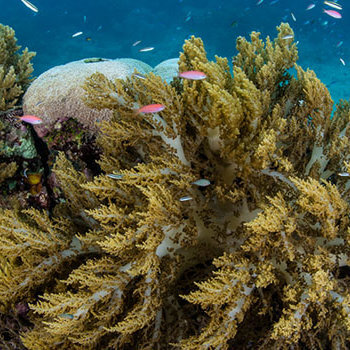
Papua New Guinea trip report 2019

Commensal crustaceans of Kimbe Bay
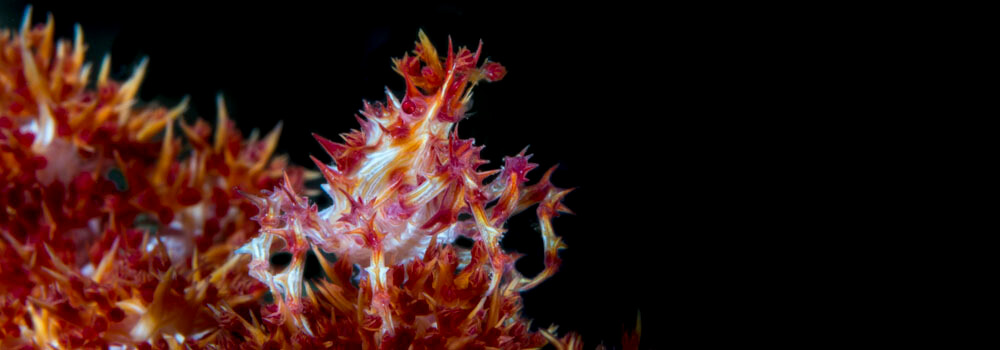
Kimbe Bay, PNG trip report
